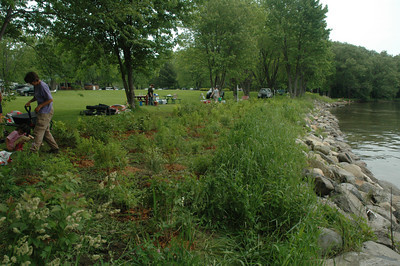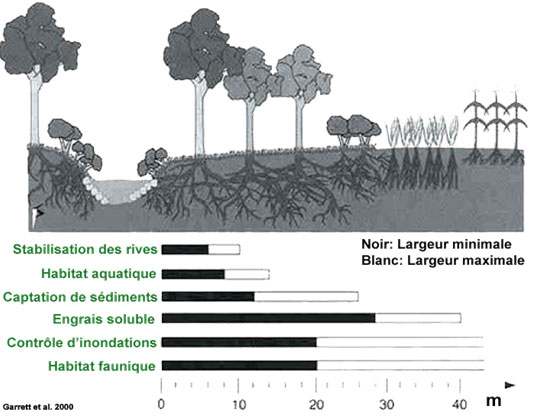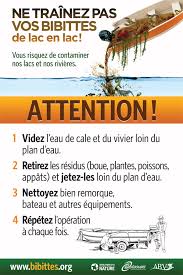Shoreline Buffer Zones
Context
The shoreline buffer zones of streams, rivers and other bodies of water in the Lake Memphremagog watershed are the last defense for the protection of this large potable water reservoir that is the lake. In fact, these shoreline buffer zones play a crucial role in the lake’s protection, and their destruction has been a leading cause of the degradation in the quality of the water of the lake, contributing to its accelerated eutrophication and to the proliferation of cyanobacteria. Luckily, Quebeckers have started to recognize their importance, and a number of municipalities in the watershed have enacted by-laws to formally forbid their destruction, and to require their re-establishment in cases where they have been eliminated. Much renaturalization work remains to be done, but at least this work has begun.
What is a shoreline buffer zone?
The shoreline buffer zone is that section of land that borders lakes and other bodies of water. In its natural state, this zone can go a long way towards protecting aquatic areas by creating a barrier against pollution. Nonetheless, in order to play its full role, this zone needs to be large enough, be composed of indigenous plants, and contain three strata: grasses, shrubs and trees.
Restoration of the shoreline buffer zone at Weir Park in the municipality of Ogden

What are the benefits provided by shoreline buffer zones?
To maintain water quality for the long term, it is primordial to ensure the natural character of the shoreline, for the buffer zone plays a number of roles:
Sanitation functions
When rainwater hits the ground, it trickles towards streams rivers and lakes, carrying with it some of the contaminants found in the soil, such as sediments, nutrients, pesticides, herbicides and bacteria. Acting as a natural barrier, the vegetated zone will take up some of these elements, reducing the amount entering the waterway. In actual fact, the presence of trees, shrubs and other plants on the ground reduces the speed at which the water trickles, reducing its capacity to carry contaminants long distances. This gives the water time to soak into the soil, where the contaminants will be deposited before reaching the waterway. Also, the roots of the plants will absorb nutrients as well as holding back soil, protecting the shoreline from erosion and landslides. The buffer zone thus acts as a filter, preserving the quality of the water for drinking and swimming, but also protecting the entire aquatic ecosystem.
Ecological functions
These buffer zones help protect aquatic as well as shoreline habitats. Shoreline vegetation provides food and shelter to a number of animal species. As well, trees provide shade, maintaining cooler water temperatures even in the heat of summer. Many fish species, including trout and salmon do not like warm water. In fact, as water temperatures increase, the amount of dissolved oxygen in the water decreases. Since these fish require a lot of oxygen, warm water temperatures are harmful to them. As well, the buffer zones also protect fish by reducing the volume of sediments entering the water. Too much sediment in the water can kill the fish by irritating their gills, eyes and scales.
Protection of landscape esthetics
The intake of nutrients into lakes causes excessive growth of aquatic plants and algae, including toxic and invasive species. These reduce the clarity of the water, change its odor and taste and reduce its quality, thus increasing the costs of treating it for domestic purposes, reduce the amount of dissolved oxygen, and impede recreational boating. The presence of a proper buffer zone will maintain the natural character of the shoreline, contributing to higher property values by reducing the nuisance factor linked to excessive flow of nutrients into the waterway.
What is the ideal width of a buffer zone?
In order to ensure that the buffer zone can provide adequate ecological services, as described above, it is important that it be sufficiently wide. According to the Quebec government’s policy on the protection of shorelines, littorals and flood zones, the protected zone should have a minimum width of 10 metres on shorelines with slopes of less than 30 %. For steeper slopes, this protection should be at least 15 metres. Thus, the steeper the slope, the wider the required buffer zone needed to ensure the ruggedness of the vegetation and to slow as much as possible the speed of the flow to the waterway. A combination of grasses, shrubs and trees will also maximize the purifying effect of the zone, and increase the diversity of the wildlife habitat. For example, a narrow buffer zone of 6 metre will stabilize the shoreline efficiently, but a wide zone of 28 metres will ensure all of the ecological services that a buffer zone can provide (figure 1). It should be noted that a buffer zone is more effective when combined with fertilizer, runoff and erosion control programs (proper septic system maintenance, elimination of the use of fertilizers, avoiding the use of soaps containing phosphates, elimination of bare soil, etc.).
Beneficial effects of shoreline buffer zones as a function of their width

Source: Garret et al., 2000.
The buffer zone of my shoreline or waterway is degraded, what should I do?
If the buffer zone has been damaged or destroyed, it should be renaturalized. Many municipalities have by-laws requiring the renaturalization of damaged buffer zones. There are three ways to go about renaturalizing: one can let vegetation grow naturally so that the zone repairs itself over time, undertake the planting of appropriate plants oneself, or hire experts to undertake the work. For more information on the proper techniques, please refer to the section on renaturalization in the glossary. To see what else you can do, refer to the appropriate section of the Stakeholders’ Guide. MCI offers its members a free one hour consultation on the renaturalization of the shoreline.
To learn more:
- MRC de Memphrémagog, 2008. Règlement du Schéma d'aménagement concernant la bande riveraine.
- Ville de Magog, 2008. Guide explicatif pour les riverains concernant les nouvelles dispositions du règlement sur la protection des berges.
- Ville de Magog, 2008. Accroche-porte au sujet des rives.
- Ville de Magog, 2008. Règlement sur la protection des berges.
- Ville de Magog, 2008. Présentation sur la bande riveraine et la renaturalisation des rives.
- MDDEP, 2007. Efficacité des bandes riveraines.
- OMAAAR, 2007. Les bandes riveraines et la qualité de l'eau: une revue de littérature.
- RAPPEL, 2005. Fiche technique sur la Bande riveraine.
- Guide du RAPPEL pour la revégétalisation
- Liste de quelques arbres et plantes indigènes avec photos et descriptions d'Aménagements Natur'Eau lac.
- Liste des végétaux du RAPPEL
- Guide d'interprétation de la Politique de protection des rives, du littoral et des plaines inondables du MDDELCC
- Firmes spécialisées dans le domaine de la restauration des berges.
Sources :
- Conseil de bassin de la rivière Etchemin (CBE), 2005. Symbiose, le bulletin officiel du Conseil de bassin de la rivière Etchemin. (page consultée le 21 octobre 2008)
- Centre de Conservation des Sols et de l'Eau de l'est du Canada (CCSE), 2007. Les bandes riveraines et la qualité de l'eau: une revue de la littérature (9 février 2007).
- Duchemin, M. et Majdoub, R., 2004. Les bandes végétales filtrantes : de la parcelle au bassin versant. IRDA, Vecteur environnement, vol. 37, no 2, p.36-50.
- Gagnon, E. et Gangbazo, G. (2007). Efficacité des bandes riveraines : analyse de la documentation scientifique et perspectives, Québec, Ministère du Développement durable, de l'Environnement et des Parcs, Direction des politiques de l'eau, 17 p.
- Goupil, J.Y., 2002. Protection des rives, du littoral et des plaines inondables: guide des bonnes pratiques, Québec, ministère de l'Environnement et de la Faune, Service de l'aménagement et de la protection des rives et du littoral, 174 p.
- Regroupement des Associations Pour la Protection de l'Environnement des Lacs et cours d'eau de l'Estrie et du haut bassin de la Saint-François (RAPPEL), 2008. L'eutrophisation (vieillissement) des lacs. In Accueil. Lacs, Eutrophisation, [En ligne]. http://www.rappel.qc.ca/lac/eutrophisation/5-lac/27-leutrophisation-vieillissement-des-lacs.html (page consultée le 21 octobre 2008)
- Zone d'intervention prioritaire (ZIP) ALMA-JONQUIÈRE, 2008. Techniques de stabilisation végétale. Document PDF.

